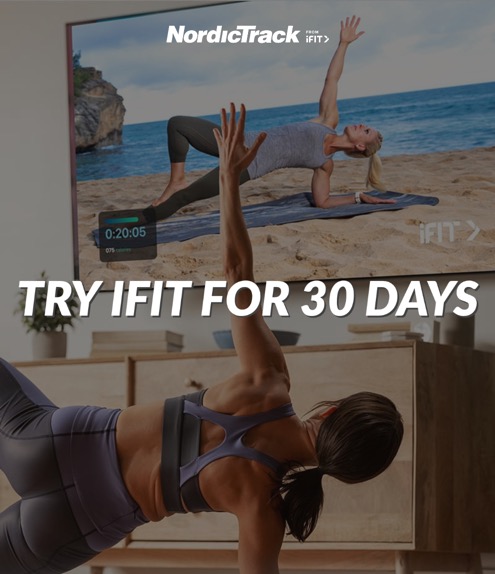
Stronger Core, Smarter Cardio: Why Elliptical Workouts Build More Than Endurance
If we’ve been putting in the miles on the elliptical, we already know it delivers a solid cardio session. But what many of us may not realize is that the right elliptical workout can also help us train our core, without relying on traditional crunches.
When we focus on posture, stay mindful of movement, and adjust intensity with purpose, the elliptical becomes more than just a cardio tool. It turns into a full-body, low-impact strength platform. We’re activating the glutes, engaging the core for stability, and strengthening the muscles that support balance, posture, and mobility—all while keeping pressure off the joints.
With the right strategy and equipment, we can build strength that supports everything we do, both in and out of training.
Here’s how to get started.
Why Core Strength Matters More Than We Think

Core strength goes far beyond visible abs, and even beyond an elliptical workout. It’s about stability, balance, and control. This is the foundation for how your body moves, stands, and recovers. A strong core plays a direct role in:
- Maintaining upright posture and spinal alignment, especially during long hours of sitting or standing3
- Stabilizing the pelvis and hips to reduce wasted energy with each step or stride6
- Supporting efficient breathing and bracing during physical activity6
- Improving balance and lowering fall risk as you age1
According to the American College of Sports Medicine (ACSM), reduced muscle strength and stability contribute significantly to balance loss in older adults. But with regular training, especially exercises that challenge your posture and coordination, it’s possible to regain balance, improve postural control, and reduce the likelihood of fall-related injuries1.
The best part? When you use your elliptical with intention, such as maintaining posture, engaging your core, and adding resistance or incline, you activate many of these essential systems in one smooth, low-impact workout.
Core Activation and Trunk Control on Ellipticals
Ellipticals like the NordicTrack X16 and Step Climber are designed for low-impact, full-body movement, and with proper posture, they do more than challenge your legs. These machines encourage upright coordination between your upper and lower body, helping to activate the muscles that stabilize your spine.
Research shows that activating the transversus abdominis (TrA), the deepest core stabilizer, improves lumbar support, postural control, and neuromuscular efficiency during upright movement and load-bearing tasks6. Adding incline or resistance can enhance this effect by increasing trunk demand.

With consistent form, elliptical training can help improve:
- Trunk control through rhythmic, alternating movement
- Core engagement from deep stabilizers like the TrA, obliques, and spinal erectors
- Spinal protection, by promoting balance and minimizing unwanted rotation
And because the motion stays smooth and impact-free, you’ll strengthen your core without stressing your joints. This is essential for each elliptical workout.
Core Elliptical Moves: Start With These 3
These core elliptical moves are built to challenge the trunk while helping us maintain clean, effective form. They can be layered into any elliptical workout to improve strength, stability, and control.
1. Posterior Chain Focus
Pressing through the heels shifts engagement to the glutes and hamstrings, which are critical stabilizers of the pelvis and lower back. Combining this with upright posture and a neutral pelvis creates a strong foundation for core activation.

2. Reverse Pedaling Rounds
Pedaling backward changes how the hips and lower back engage. Start with 60-second rounds every 5 minutes. The Step Climber is especially effective here, using a stair-stepping motion that naturally lights up the core from multiple angles.
3. Resistance Ladder
Select a 20-minute workout and increase resistance by two levels every 3 minutes. This forces the body to brace under load, similar to strength training. SmartAdjust™ on NordicTrack ellipticals can make these changes automatically, adapting to performance in real time.
Intermediate-to-Advanced Core Routine
This routine is designed to help us build true core strength through our elliptical workout, starting with foundational movements and progressing in intensity. It works well for those ready to go beyond the basics and add targeted core challenges into their cardio.
| Segment | Time | Instructions |
| Warm-Up | 3–5 minutes | Move at an easy pace, use full stride, and focus on steady breathing |
| Reverse Pedaling | 1–2 minutes | Add moderate resistance, maintain smooth movement |
| Resistance Ladder | 10 minutes | Increase resistance every 2–3 minutes to build strength |
| Posture + Brace Focus | 2 minutes | Slightly reduce speed, brace the core as if holding a plank |
| Cool Down | 2–3 minutes | Return to a light pace, relax the arms, and shake out the legs |
Try this routine three to four times per week. Start with shorter intervals if needed and build up gradually. The key is staying consistent. Small, focused sessions create real progress over time.
Which NordicTrack Ellipticals Support Core Training Best?

When core strength is the goal, the right machine can make a big difference. Here are two standout options from the NordicTrack lineup that bring serious value to your routine.
X16 Elliptical
This machine delivers unmatched variety. With its 3-in-1 design, you can move like you’re on an elliptical, a stepper, or even a treadmill, keeping workouts dynamic and muscles fully engaged.
- A 32-inch auto-adjustable stride design allows for stride variety and incline/decline settings that may support a dynamic workout experience.
- Incline and decline ranges from -10% to 10% challenge the core through elevation changes
- Built for cross-training, this model is ideal for improving strength, stamina, and balance together
Best for: Those ready to level up with advanced full-body variety and dynamic core activation.
Step Climber
This compact, stair-stepping elliptical delivers consistent, controlled intensity, making it perfect for engaging your core every step of the way.
- The vertical motion encourages upright posture and coordinated movement
- Smaller footprint fits easily into home setups
- iFIT trainer-led workouts on this model include cues and stability challenges that keep your core working throughout
Best for: Focused core training with joint-friendly movement and strong posture reinforcement.
Both models pair seamlessly with iFIT SmartAdjust™ and the AI Coach, making it easier for us to follow a routine that evolves as we get stronger. Whether we’re building a base or pushing for next-level progress, these machines help us train with purpose.
SmartAdjust™ automatically scales your workout intensity based on your performance. iFIT AI Coach is currently in beta and features may change or be limited. Availability of both features may vary depending on equipment model and workout type.
The iFIT Advantage: Why Core Gains Stick
iFIT isn’t just cardio coaching. It’s a full training experience that supports your form, focus, and core engagement from start to finish. Every elliptical workout includes posture reminders, breathing cues, and motivational coaching to help you stay consistent and strong.
- SmartAdjust™ automatically adapts incline and resistance based on your effort
- AI Coach builds weekly plans that align with your goals and training level
- On-screen metrics help you track progress in posture, stability, and endurance
iFIT provides trainer-led workouts that include reminders for posture, breathing, and coordination. These instructional cues are designed to support consistent and structured training experiences.
Explore iFIT Core-Focused Elliptical Programs: Discover trainer-led routines that emphasize strength, posture, and balance.
Advanced Tips to Elevate Core Activation
Once you’ve built a strong foundation, these strategies can help take your core engagement to the next level during and after your elliptical workout:
- Add Tabata Intervals: Alternate 20 seconds of high-effort pedaling with 10 seconds of recovery, repeated for 8 rounds. This boosts intensity and challenges your core to stay braced under fatigue.
- Use a Weighted Vest: Adding light external weight increases trunk activation and postural demand. Be sure to consult a medical professional before incorporating added load.
- Finish with Floor Core Work: After your ride, reinforce your training with planks, bird dogs, or dead bugs. These exercises target core control under fatigue and help improve stability over time.
Your Next Steps
- Choose your machine: NordicTrack X16 or Step Climber
- Start with 15–20 minute elliptical workouts focused on core control
- Explore iFIT trainer-led elliptical plans for form-focused progressions
- Add a few floor core moves post-ride to round out your strength
- Want a coach to guide the way? Try iFIT’s AI Coach, where Tailor learns your habits and builds a full-body plan, day by day.
FAQ: Elliptical Core Training, Answered
Elliptical workouts support core engagement by promoting upright posture, balance, and full-body coordination. While not a direct replacement for core-specific strength training, using proper form and adding incline or resistance can help activate your midsection as you stabilize through each stride. According to the Mayo Clinic, aerobic exercises like elliptical training improve stamina and posture3.
Elliptical workouts train your core functionally, supporting real-world movements like standing, twisting, and stabilizing, rather than just isolating surface muscles.
Both are excellent. The X16 offers stride variety and incline/decline training. The Step Climber delivers concentrated, repetitive stepping that targets core stability.
A. Aerobic activities like elliptical training can contribute to overall energy expenditure. The actual number of calories burned varies based on individual factors such as weight, fitness level, workout intensity, and duration. The American Heart Association provides general estimates for various aerobic activities, which can offer a helpful point of reference. According to the AHA, a 150-pound person burns approximately:
224 calories/hour walking at 3 mph
544 calories/hour biking at 12–13 mph
476 calories/hour swimming casually2
Yes. Elliptical workouts are considered joint-friendly and are recommended for individuals managing arthritis or joint discomfort. According to the Mayo Clinic, low-impact exercises like elliptical training can help reduce pain, ease stiffness, and strengthen the muscles that support and protect your joints, including your core4. The key is to start slowly, maintain good posture, and avoid moves that feel unstable, like one-leg drills, until your strength and balance improve. You can also use SmartAdjust™ to keep intensity within a comfortable range.
With consistent strength-focused elliptical and resistance training 2–3 times per week, most people see improved posture, core endurance, and functional strength within a few weeks. Muscle tone often becomes more visible after a couple of months. Results vary based on intensity, biomechanics, and nutrition6.
Not required, but iFIT simplifies structure, coaching, and accountability. For best results, pair your elliptical with an iFIT plan that fits your level.
References
- American College of Sports Medicine (ACSM). Selecting and Effectively Using Balance Training for Older Adults.
- American Heart Association. Is Your Workout Working? Infographic.
- Mayo Clinic. Aerobic Exercise: Top 10 Reasons to Get Physical.
- Mayo Clinic. Arthritis and Exercise: How Does Activity Help?
- Mayo Clinic. Strength Training: Get Stronger, Leaner, Healthier.
- ScienceDirect. Enhancing core stability and strength through abdominal drawing-in maneuver training using a sphygmomanometer: A narrative review.
Disclaimer: The primary purpose of this blog post is to inform and entertain. Nothing on the post constitutes or is intended to be a substitute for professional medical advice, prevention, diagnosis, or treatment. Reliance on any information provided on the blog is solely at your own risk. Always seek the advice of your physician or other qualified health provider with any questions you may have regarding a medical condition, and please consult your doctor or other health care provider before making any changes to your diet, sleep methods, daily activity, or fitness routine. Do not disregard professional medical advice or delay seeking it because of information available on this blog. NordicTrack assumes no responsibility for any personal injury or damage sustained by any recommendations, opinions, or advice given in this article. Always follow the safety precautions included in the owner’s manual of your fitness equipment.


